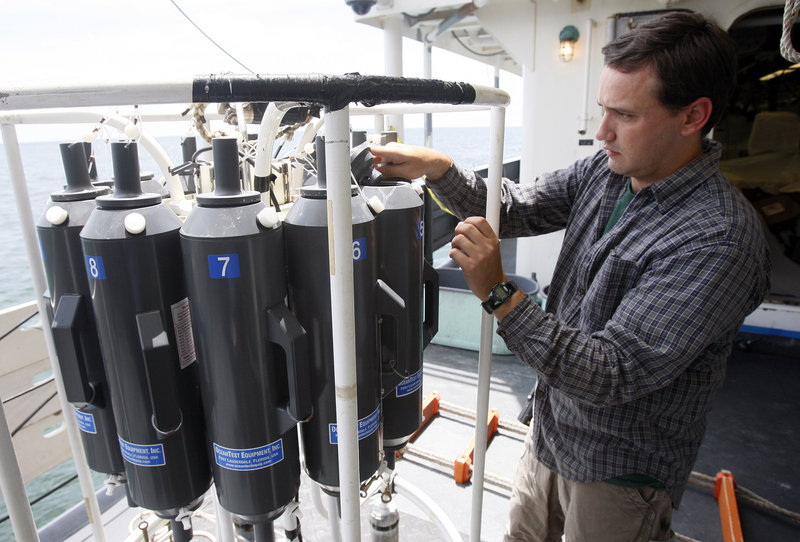MIAMI — A team of University of Georgia scientists on Tuesday disputed the Obama administration’s claim two weeks ago that most of the oil spewed from BP’s Deepwater Horizon well is either gone or widely dispersed.
Far from gone or dispersed, the scientists said, 70 percent to 79 percent of the more than 4 million barrels of oil that escaped into the Gulf of Mexico remains in the water, posing real but still undetermined risks.
“The idea that 75 percent of the oil is gone and of no concern for the environment is just absolutely incorrect,” said Charles Hopkinson, a director of Georgia Sea Grant and a marine science professor at the University of Georgia, who co-authored the report.
The Georgia report blamed the media for “inaccurate and misleading” interpretation of a federal analysis released Aug. 2. But its authors, in a teleconference, declined to address questions about whether an upbeat spin by the Obama administration had shaped coverage.
The federal report, produced by government and independent scientists, estimated that the “vast majority” of the 4.9 million barrels of crude released into the Gulf had evaporated or been burned, skimmed, recovered by BP from the wellhead, or dispersed naturally or by chemicals into drops likely to be rapidly consumed by microbes. Only 26 percent of “residual” oil remained largely in the form of sheen or tarballs, the federal report found — still a volume four times the amount spilled by the Exxon Valdez.
In announcing the data, Jane Lubchenco, administrator of the National Oceanic and Atmospheric Administration, cautioned that the vast amount of oil would cause impacts for years, but she still struck a glass-half-full tone echoed by other Obama aides.
“At least 50 percent of the oil that was released is now completely gone from the system, and most of the remainder is degrading rapidly or is being removed from the beaches,” she said at a White House conference.
Two calculations explain the bulk of the difference in the Georgia report, produced by Hopkinson with four colleagues at the University of Georgia and the Skidaway Institute of Oceanography.
The Georgia report tossed out 800,000-plus barrels that BP managed to pipe directly from the well after it had fitted a sealing cap on the gusher — 17 percent of the well’s estimated flow — arguing that that oil had never actually “spilled” into the Gulf.
More significantly, the report also dramatically reduced the amount of oil estimated to have evaporated, to 7-12 percent. The federal study’s estimate was 25 percent.
The government’s evaporation estimate was based on a standard accepted by industry experts and researchers for light sweet crude in the warm Gulf. But Hopkinson argued that the percentage is invalid because much of the oil remains deep beneath the surface, trapped under dense temperature and salinity layers that would dramatically limit evaporation.
“My suspicion is that a large fraction of this oil is still in the system,” said Samantha Joye, a UGA marine scientist who in May was the first researcher to detect massive deep sea “plumes” of oil droplets spreading from the well. “Whether it’s floating around or down in the bottom, we still don’t know.”
Another report released Tuesday by University of South Florida researchers found evidence of droplets spreading eastward up the continental shelf and settling into the DeSoto Canyon, a much shallower area considered a prime spawning spot for fish. The team reported finding oil at potentially toxic concentrations for some organisms in sediment taken from 900 feet to as shallow as 215 feet. BP’s well is 5,000 feet deep.
Most analysis and research to date, Georgia’s Joye said, also has ignored methane, which accounted for as much as one-third of the overall flow. Methane levels were 10,000 to 100,000 times greater than normal in some deep sea pockets, Joye said. At such levels, it could take a year for the dissolved methane to dissipate, she said.
In an e-mail statement Tuesday, NOAA spokesman Justin Kenney defended the official analysis as “validated by federal and independent scientific experts.” omitting oil recovered directly from the well, he said, the Georgia researchers had fundamentally changed the baseline calculation, making it impossible to compare the two estimates.
He also dismissed critics who have contended the White House was eager to put the environmental disaster in its rearview mirror. NOAA and its contributing independent scientists, he said, “have been clear that oil and its remnants left in the water represent a potential threat.”
The agency intended to continue to “rigorously monitor, test and assess short- and long-term ramifications,” he said.
Joye stressed that the Georgia team wasn’t implying that there were toxic “rivers of oil” submerged in the Gulf. Oil is degrading every day, she said.
There are, however, still vast volumes of crude oil in the water column, widely dispersed and breaking down into multiple compounds whose impact on the environment won’t be understood for years, she said.
Send questions/comments to the editors.



Success. Please wait for the page to reload. If the page does not reload within 5 seconds, please refresh the page.
Enter your email and password to access comments.
Hi, to comment on stories you must . This profile is in addition to your subscription and website login.
Already have a commenting profile? .
Invalid username/password.
Please check your email to confirm and complete your registration.
Only subscribers are eligible to post comments. Please subscribe or login first for digital access. Here’s why.
Use the form below to reset your password. When you've submitted your account email, we will send an email with a reset code.